MKT202 Marketing Research: Factors in Optus Brand Switching
VerifiedAdded on 2023/01/18
|8
|1309
|20
Report
AI Summary
This report presents a detailed market research proposal focused on identifying the factors behind brand switching in the telecom industry, specifically within Optus, Australia. The proposal begins with an introduction to the topic and the organization, followed by a clear articulation of the management and research problems. The research objectives are defined to understand the conceptual basis of brand switching, identify the key factors influencing it within Optus, and recommend strategies for improving the brand experience. The proposed research methodology includes desk research (secondary research), qualitative research using depth interviews with Optus managers, and a quantitative survey of customers who have switched from Optus. The research will be analyzed using statistical methods, including univariate data techniques and MS-Excel for data representation. A timeline for the research project is also provided, along with a confidentiality statement ensuring the privacy of participants and adherence to ethical research practices. The report concludes with a list of relevant references.
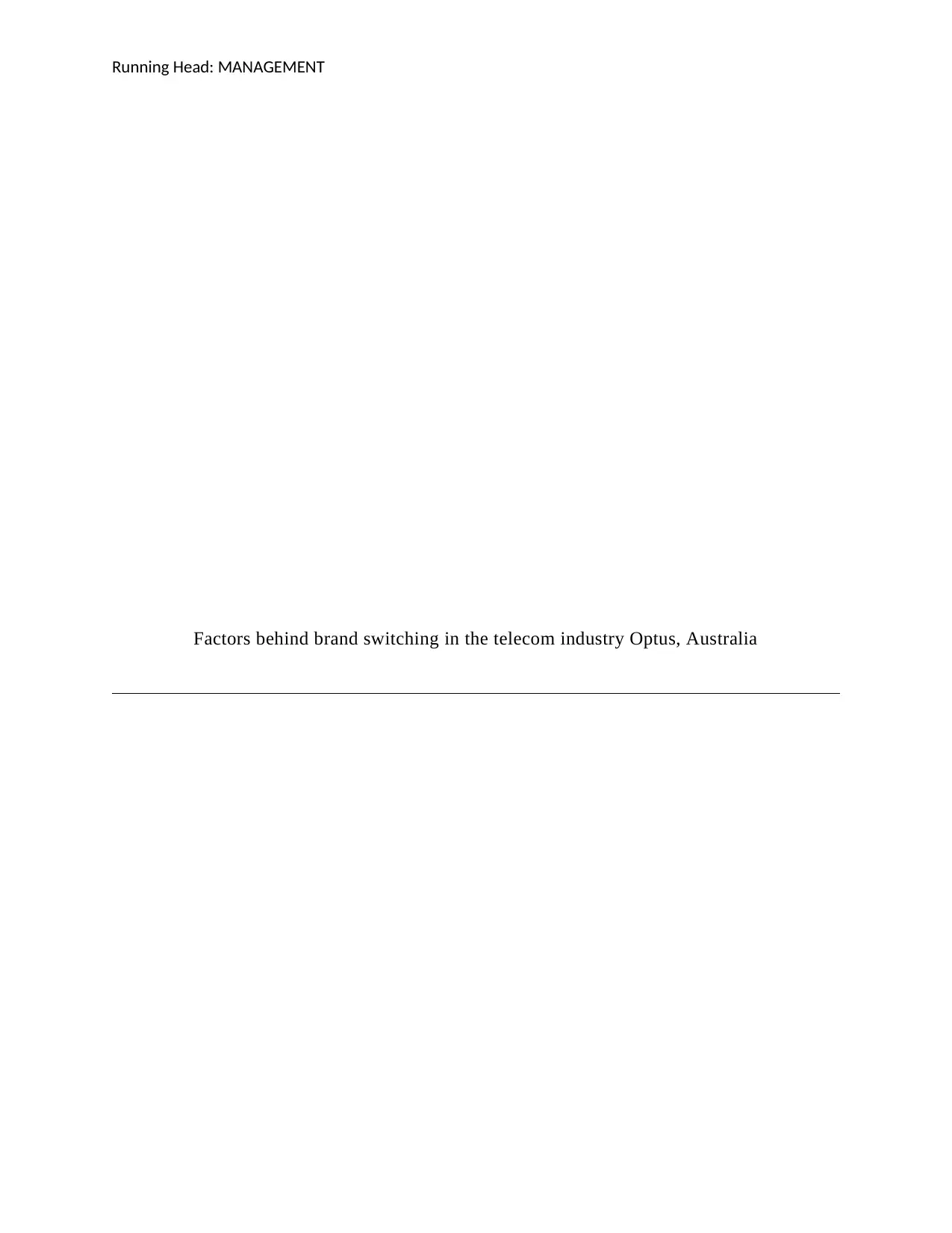
Running Head: MANAGEMENT
Factors behind brand switching in the telecom industry Optus, Australia
Factors behind brand switching in the telecom industry Optus, Australia
Paraphrase This Document
Need a fresh take? Get an instant paraphrase of this document with our AI Paraphraser
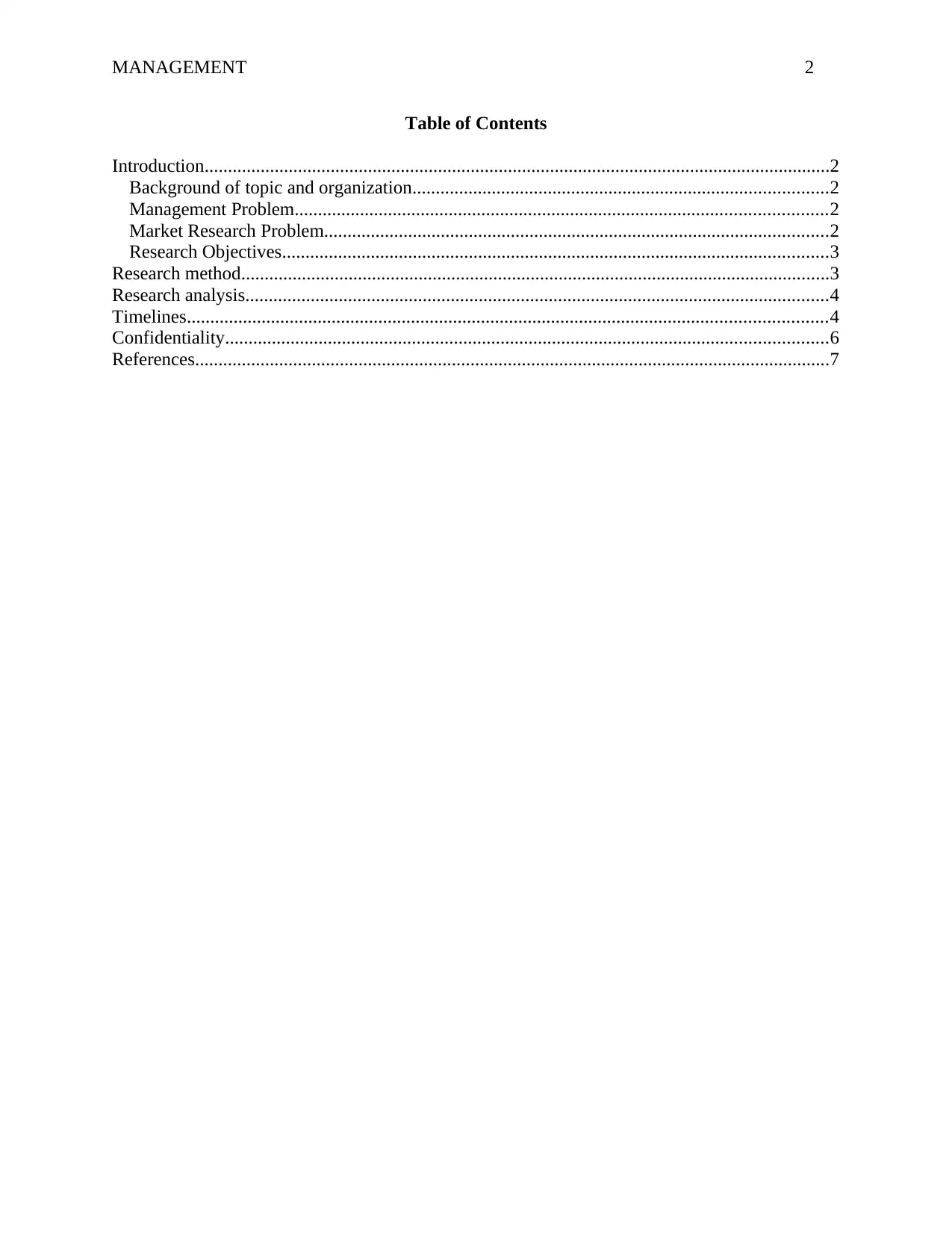
MANAGEMENT 2
Table of Contents
Introduction......................................................................................................................................2
Background of topic and organization.........................................................................................2
Management Problem..................................................................................................................2
Market Research Problem............................................................................................................2
Research Objectives.....................................................................................................................3
Research method..............................................................................................................................3
Research analysis.............................................................................................................................4
Timelines.........................................................................................................................................4
Confidentiality.................................................................................................................................6
References........................................................................................................................................7
Table of Contents
Introduction......................................................................................................................................2
Background of topic and organization.........................................................................................2
Management Problem..................................................................................................................2
Market Research Problem............................................................................................................2
Research Objectives.....................................................................................................................3
Research method..............................................................................................................................3
Research analysis.............................................................................................................................4
Timelines.........................................................................................................................................4
Confidentiality.................................................................................................................................6
References........................................................................................................................................7
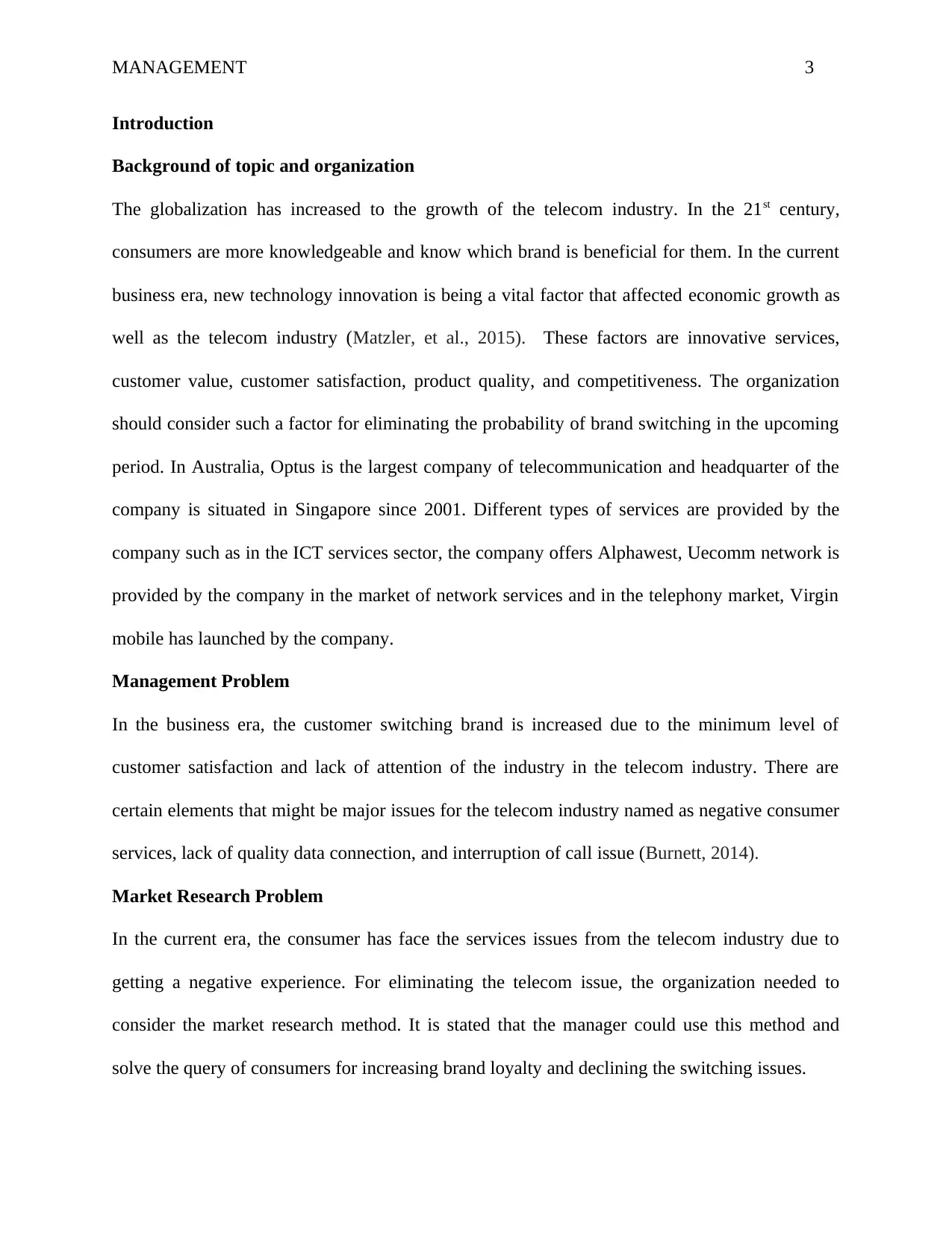
MANAGEMENT 3
Introduction
Background of topic and organization
The globalization has increased to the growth of the telecom industry. In the 21st century,
consumers are more knowledgeable and know which brand is beneficial for them. In the current
business era, new technology innovation is being a vital factor that affected economic growth as
well as the telecom industry (Matzler, et al., 2015). These factors are innovative services,
customer value, customer satisfaction, product quality, and competitiveness. The organization
should consider such a factor for eliminating the probability of brand switching in the upcoming
period. In Australia, Optus is the largest company of telecommunication and headquarter of the
company is situated in Singapore since 2001. Different types of services are provided by the
company such as in the ICT services sector, the company offers Alphawest, Uecomm network is
provided by the company in the market of network services and in the telephony market, Virgin
mobile has launched by the company.
Management Problem
In the business era, the customer switching brand is increased due to the minimum level of
customer satisfaction and lack of attention of the industry in the telecom industry. There are
certain elements that might be major issues for the telecom industry named as negative consumer
services, lack of quality data connection, and interruption of call issue (Burnett, 2014).
Market Research Problem
In the current era, the consumer has face the services issues from the telecom industry due to
getting a negative experience. For eliminating the telecom issue, the organization needed to
consider the market research method. It is stated that the manager could use this method and
solve the query of consumers for increasing brand loyalty and declining the switching issues.
Introduction
Background of topic and organization
The globalization has increased to the growth of the telecom industry. In the 21st century,
consumers are more knowledgeable and know which brand is beneficial for them. In the current
business era, new technology innovation is being a vital factor that affected economic growth as
well as the telecom industry (Matzler, et al., 2015). These factors are innovative services,
customer value, customer satisfaction, product quality, and competitiveness. The organization
should consider such a factor for eliminating the probability of brand switching in the upcoming
period. In Australia, Optus is the largest company of telecommunication and headquarter of the
company is situated in Singapore since 2001. Different types of services are provided by the
company such as in the ICT services sector, the company offers Alphawest, Uecomm network is
provided by the company in the market of network services and in the telephony market, Virgin
mobile has launched by the company.
Management Problem
In the business era, the customer switching brand is increased due to the minimum level of
customer satisfaction and lack of attention of the industry in the telecom industry. There are
certain elements that might be major issues for the telecom industry named as negative consumer
services, lack of quality data connection, and interruption of call issue (Burnett, 2014).
Market Research Problem
In the current era, the consumer has face the services issues from the telecom industry due to
getting a negative experience. For eliminating the telecom issue, the organization needed to
consider the market research method. It is stated that the manager could use this method and
solve the query of consumers for increasing brand loyalty and declining the switching issues.
⊘ This is a preview!⊘
Do you want full access?
Subscribe today to unlock all pages.

Trusted by 1+ million students worldwide
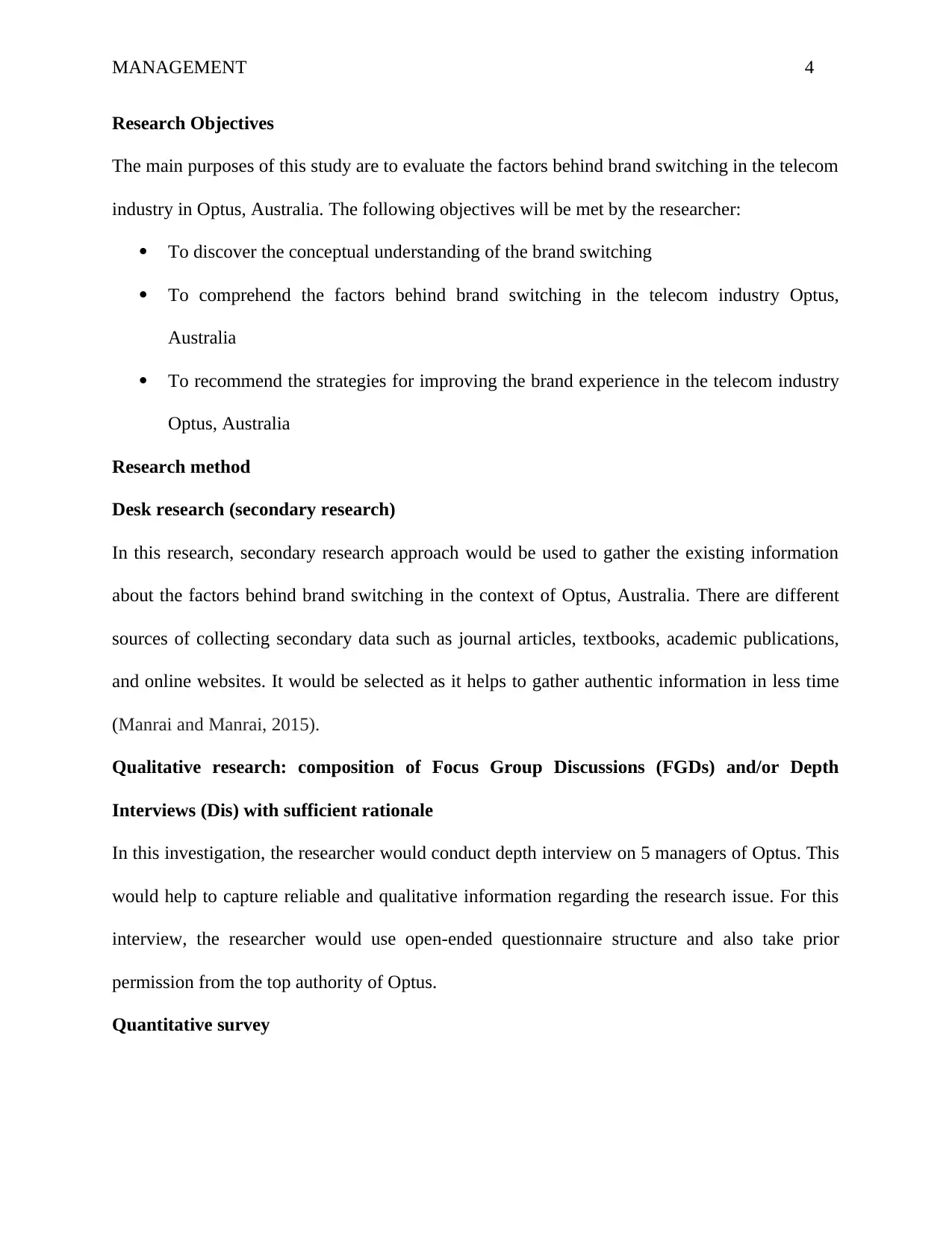
MANAGEMENT 4
Research Objectives
The main purposes of this study are to evaluate the factors behind brand switching in the telecom
industry in Optus, Australia. The following objectives will be met by the researcher:
To discover the conceptual understanding of the brand switching
To comprehend the factors behind brand switching in the telecom industry Optus,
Australia
To recommend the strategies for improving the brand experience in the telecom industry
Optus, Australia
Research method
Desk research (secondary research)
In this research, secondary research approach would be used to gather the existing information
about the factors behind brand switching in the context of Optus, Australia. There are different
sources of collecting secondary data such as journal articles, textbooks, academic publications,
and online websites. It would be selected as it helps to gather authentic information in less time
(Manrai and Manrai, 2015).
Qualitative research: composition of Focus Group Discussions (FGDs) and/or Depth
Interviews (Dis) with sufficient rationale
In this investigation, the researcher would conduct depth interview on 5 managers of Optus. This
would help to capture reliable and qualitative information regarding the research issue. For this
interview, the researcher would use open-ended questionnaire structure and also take prior
permission from the top authority of Optus.
Quantitative survey
Research Objectives
The main purposes of this study are to evaluate the factors behind brand switching in the telecom
industry in Optus, Australia. The following objectives will be met by the researcher:
To discover the conceptual understanding of the brand switching
To comprehend the factors behind brand switching in the telecom industry Optus,
Australia
To recommend the strategies for improving the brand experience in the telecom industry
Optus, Australia
Research method
Desk research (secondary research)
In this research, secondary research approach would be used to gather the existing information
about the factors behind brand switching in the context of Optus, Australia. There are different
sources of collecting secondary data such as journal articles, textbooks, academic publications,
and online websites. It would be selected as it helps to gather authentic information in less time
(Manrai and Manrai, 2015).
Qualitative research: composition of Focus Group Discussions (FGDs) and/or Depth
Interviews (Dis) with sufficient rationale
In this investigation, the researcher would conduct depth interview on 5 managers of Optus. This
would help to capture reliable and qualitative information regarding the research issue. For this
interview, the researcher would use open-ended questionnaire structure and also take prior
permission from the top authority of Optus.
Quantitative survey
Paraphrase This Document
Need a fresh take? Get an instant paraphrase of this document with our AI Paraphraser
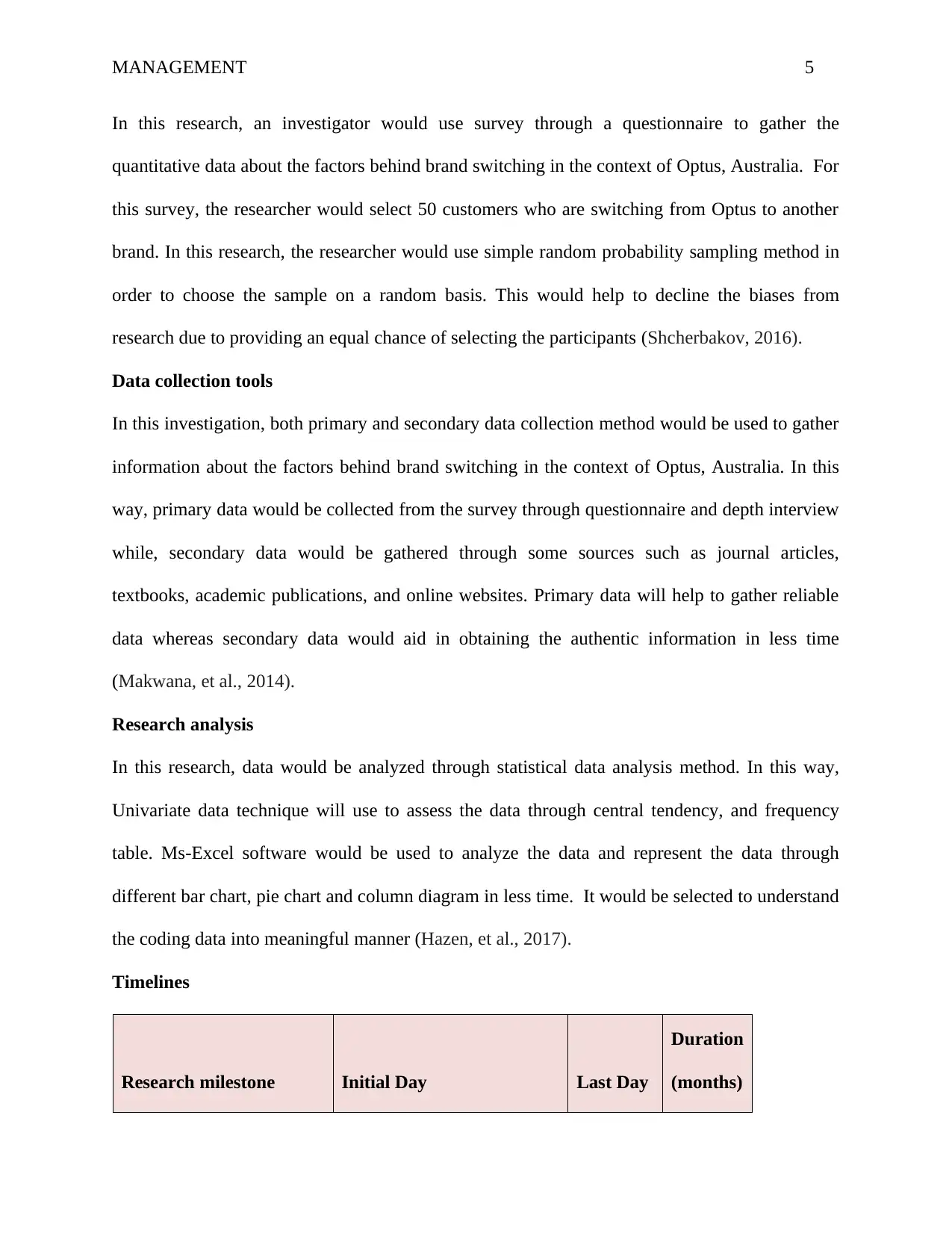
MANAGEMENT 5
In this research, an investigator would use survey through a questionnaire to gather the
quantitative data about the factors behind brand switching in the context of Optus, Australia. For
this survey, the researcher would select 50 customers who are switching from Optus to another
brand. In this research, the researcher would use simple random probability sampling method in
order to choose the sample on a random basis. This would help to decline the biases from
research due to providing an equal chance of selecting the participants (Shcherbakov, 2016).
Data collection tools
In this investigation, both primary and secondary data collection method would be used to gather
information about the factors behind brand switching in the context of Optus, Australia. In this
way, primary data would be collected from the survey through questionnaire and depth interview
while, secondary data would be gathered through some sources such as journal articles,
textbooks, academic publications, and online websites. Primary data will help to gather reliable
data whereas secondary data would aid in obtaining the authentic information in less time
(Makwana, et al., 2014).
Research analysis
In this research, data would be analyzed through statistical data analysis method. In this way,
Univariate data technique will use to assess the data through central tendency, and frequency
table. Ms-Excel software would be used to analyze the data and represent the data through
different bar chart, pie chart and column diagram in less time. It would be selected to understand
the coding data into meaningful manner (Hazen, et al., 2017).
Timelines
Research milestone Initial Day Last Day
Duration
(months)
In this research, an investigator would use survey through a questionnaire to gather the
quantitative data about the factors behind brand switching in the context of Optus, Australia. For
this survey, the researcher would select 50 customers who are switching from Optus to another
brand. In this research, the researcher would use simple random probability sampling method in
order to choose the sample on a random basis. This would help to decline the biases from
research due to providing an equal chance of selecting the participants (Shcherbakov, 2016).
Data collection tools
In this investigation, both primary and secondary data collection method would be used to gather
information about the factors behind brand switching in the context of Optus, Australia. In this
way, primary data would be collected from the survey through questionnaire and depth interview
while, secondary data would be gathered through some sources such as journal articles,
textbooks, academic publications, and online websites. Primary data will help to gather reliable
data whereas secondary data would aid in obtaining the authentic information in less time
(Makwana, et al., 2014).
Research analysis
In this research, data would be analyzed through statistical data analysis method. In this way,
Univariate data technique will use to assess the data through central tendency, and frequency
table. Ms-Excel software would be used to analyze the data and represent the data through
different bar chart, pie chart and column diagram in less time. It would be selected to understand
the coding data into meaningful manner (Hazen, et al., 2017).
Timelines
Research milestone Initial Day Last Day
Duration
(months)
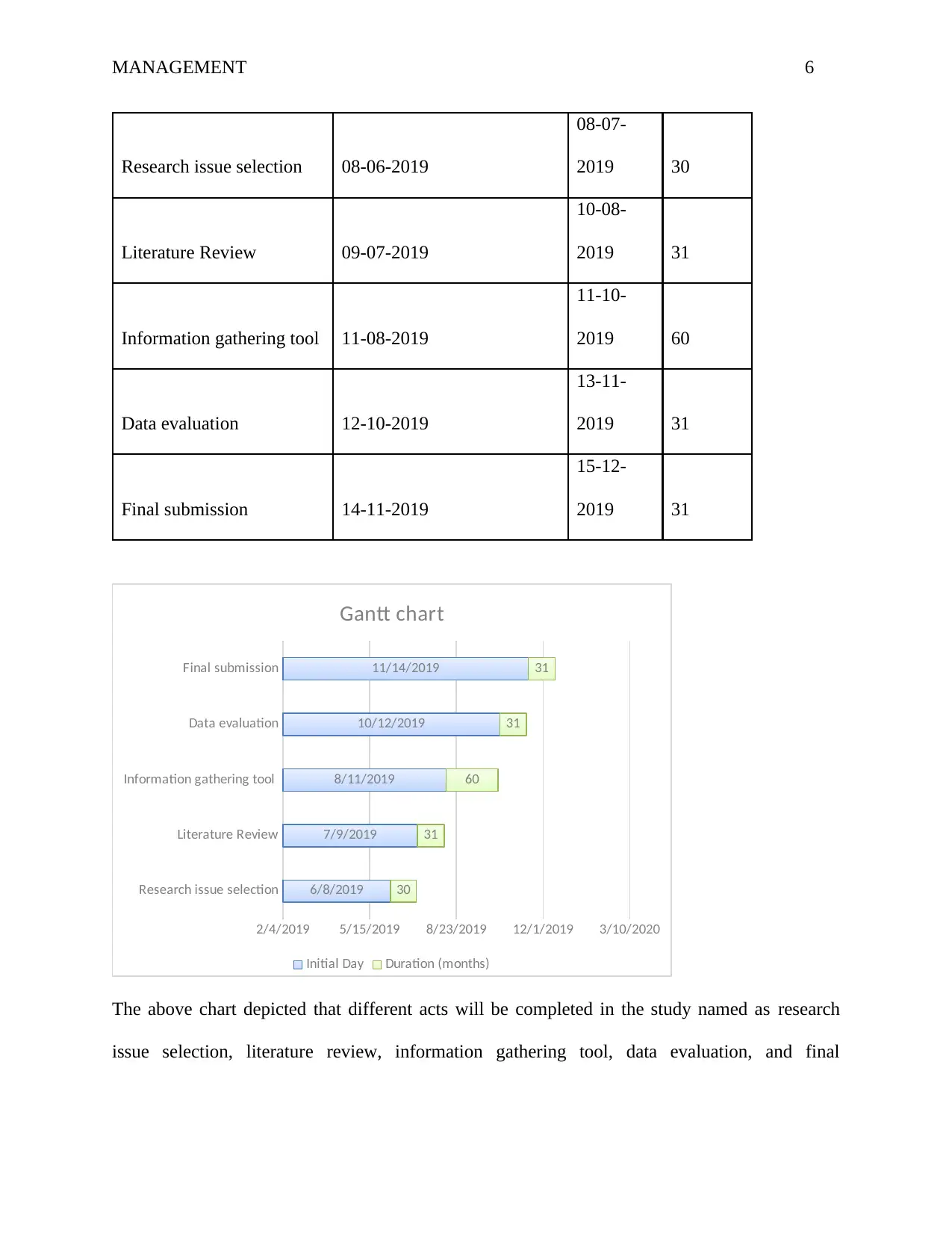
MANAGEMENT 6
Research issue selection 08-06-2019
08-07-
2019 30
Literature Review 09-07-2019
10-08-
2019 31
Information gathering tool 11-08-2019
11-10-
2019 60
Data evaluation 12-10-2019
13-11-
2019 31
Final submission 14-11-2019
15-12-
2019 31
Research issue selection
Literature Review
Information gathering tool
Data evaluation
Final submission
2/4/2019 5/15/2019 8/23/2019 12/1/2019 3/10/2020
6/8/2019
7/9/2019
8/11/2019
10/12/2019
11/14/2019
30
31
60
31
31
Gantt chart
Initial Day Duration (months)
The above chart depicted that different acts will be completed in the study named as research
issue selection, literature review, information gathering tool, data evaluation, and final
Research issue selection 08-06-2019
08-07-
2019 30
Literature Review 09-07-2019
10-08-
2019 31
Information gathering tool 11-08-2019
11-10-
2019 60
Data evaluation 12-10-2019
13-11-
2019 31
Final submission 14-11-2019
15-12-
2019 31
Research issue selection
Literature Review
Information gathering tool
Data evaluation
Final submission
2/4/2019 5/15/2019 8/23/2019 12/1/2019 3/10/2020
6/8/2019
7/9/2019
8/11/2019
10/12/2019
11/14/2019
30
31
60
31
31
Gantt chart
Initial Day Duration (months)
The above chart depicted that different acts will be completed in the study named as research
issue selection, literature review, information gathering tool, data evaluation, and final
⊘ This is a preview!⊘
Do you want full access?
Subscribe today to unlock all pages.

Trusted by 1+ million students worldwide
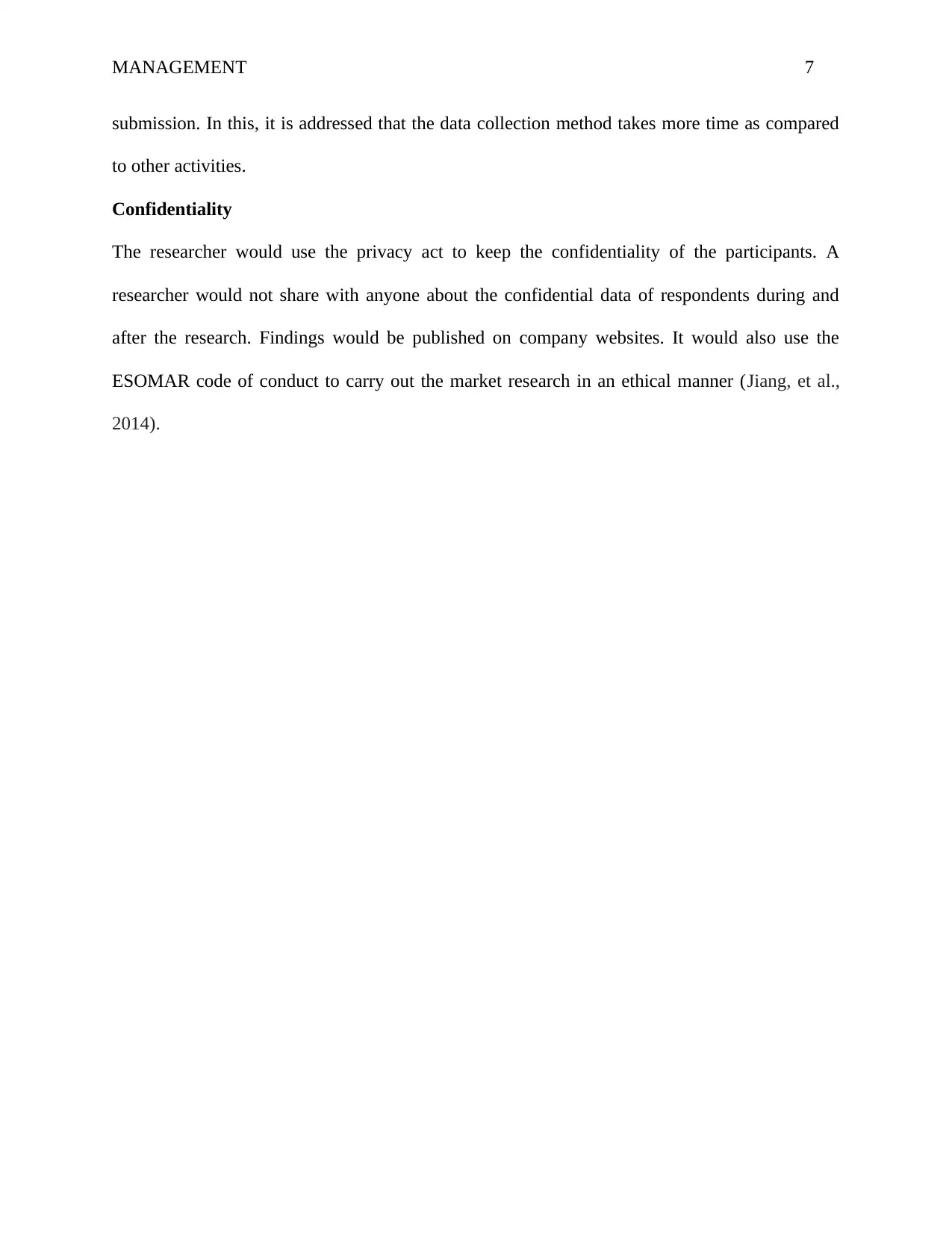
MANAGEMENT 7
submission. In this, it is addressed that the data collection method takes more time as compared
to other activities.
Confidentiality
The researcher would use the privacy act to keep the confidentiality of the participants. A
researcher would not share with anyone about the confidential data of respondents during and
after the research. Findings would be published on company websites. It would also use the
ESOMAR code of conduct to carry out the market research in an ethical manner (Jiang, et al.,
2014).
submission. In this, it is addressed that the data collection method takes more time as compared
to other activities.
Confidentiality
The researcher would use the privacy act to keep the confidentiality of the participants. A
researcher would not share with anyone about the confidential data of respondents during and
after the research. Findings would be published on company websites. It would also use the
ESOMAR code of conduct to carry out the market research in an ethical manner (Jiang, et al.,
2014).
Paraphrase This Document
Need a fresh take? Get an instant paraphrase of this document with our AI Paraphraser
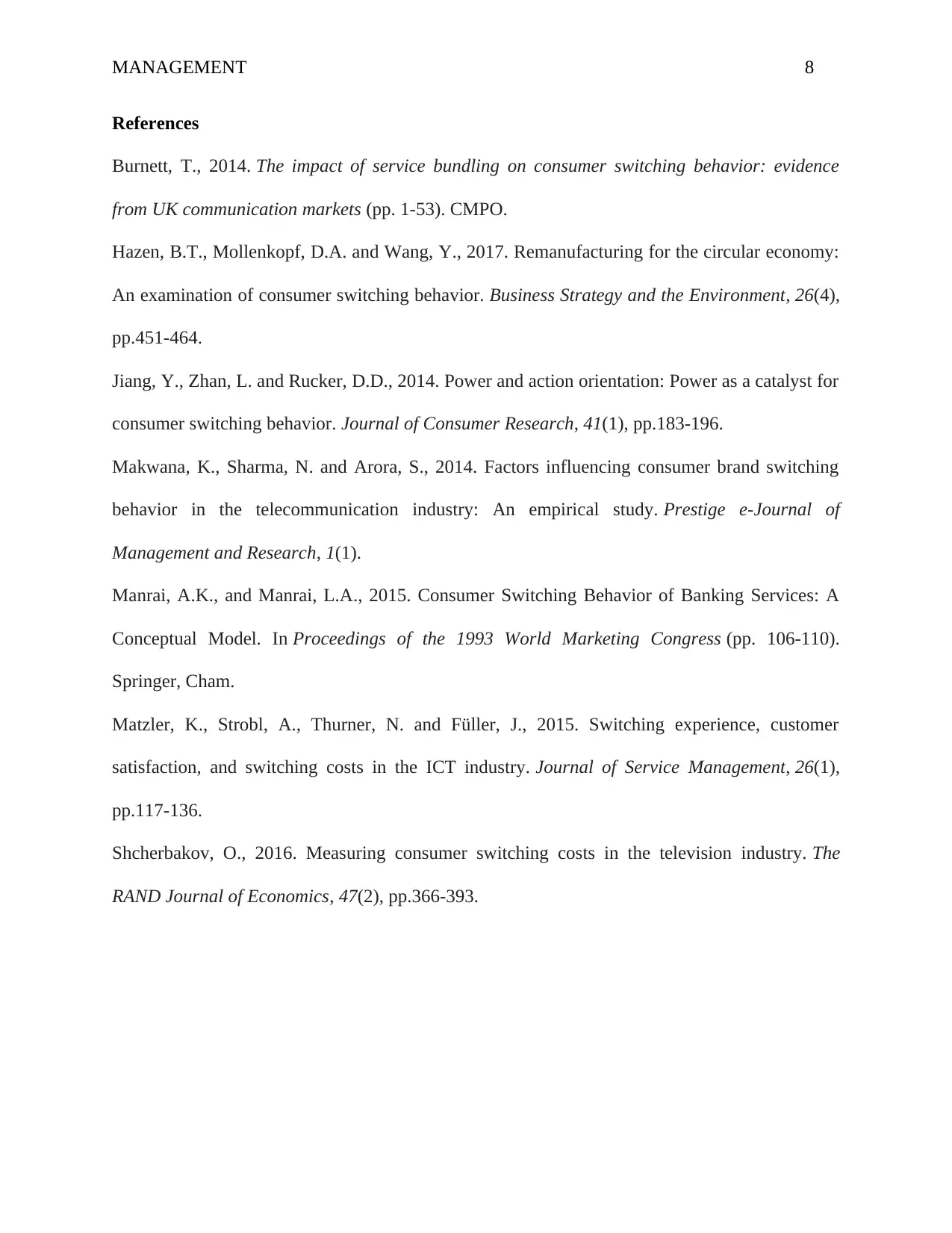
MANAGEMENT 8
References
Burnett, T., 2014. The impact of service bundling on consumer switching behavior: evidence
from UK communication markets (pp. 1-53). CMPO.
Hazen, B.T., Mollenkopf, D.A. and Wang, Y., 2017. Remanufacturing for the circular economy:
An examination of consumer switching behavior. Business Strategy and the Environment, 26(4),
pp.451-464.
Jiang, Y., Zhan, L. and Rucker, D.D., 2014. Power and action orientation: Power as a catalyst for
consumer switching behavior. Journal of Consumer Research, 41(1), pp.183-196.
Makwana, K., Sharma, N. and Arora, S., 2014. Factors influencing consumer brand switching
behavior in the telecommunication industry: An empirical study. Prestige e-Journal of
Management and Research, 1(1).
Manrai, A.K., and Manrai, L.A., 2015. Consumer Switching Behavior of Banking Services: A
Conceptual Model. In Proceedings of the 1993 World Marketing Congress (pp. 106-110).
Springer, Cham.
Matzler, K., Strobl, A., Thurner, N. and Füller, J., 2015. Switching experience, customer
satisfaction, and switching costs in the ICT industry. Journal of Service Management, 26(1),
pp.117-136.
Shcherbakov, O., 2016. Measuring consumer switching costs in the television industry. The
RAND Journal of Economics, 47(2), pp.366-393.
References
Burnett, T., 2014. The impact of service bundling on consumer switching behavior: evidence
from UK communication markets (pp. 1-53). CMPO.
Hazen, B.T., Mollenkopf, D.A. and Wang, Y., 2017. Remanufacturing for the circular economy:
An examination of consumer switching behavior. Business Strategy and the Environment, 26(4),
pp.451-464.
Jiang, Y., Zhan, L. and Rucker, D.D., 2014. Power and action orientation: Power as a catalyst for
consumer switching behavior. Journal of Consumer Research, 41(1), pp.183-196.
Makwana, K., Sharma, N. and Arora, S., 2014. Factors influencing consumer brand switching
behavior in the telecommunication industry: An empirical study. Prestige e-Journal of
Management and Research, 1(1).
Manrai, A.K., and Manrai, L.A., 2015. Consumer Switching Behavior of Banking Services: A
Conceptual Model. In Proceedings of the 1993 World Marketing Congress (pp. 106-110).
Springer, Cham.
Matzler, K., Strobl, A., Thurner, N. and Füller, J., 2015. Switching experience, customer
satisfaction, and switching costs in the ICT industry. Journal of Service Management, 26(1),
pp.117-136.
Shcherbakov, O., 2016. Measuring consumer switching costs in the television industry. The
RAND Journal of Economics, 47(2), pp.366-393.
1 out of 8
Related Documents
Your All-in-One AI-Powered Toolkit for Academic Success.
+13062052269
info@desklib.com
Available 24*7 on WhatsApp / Email
![[object Object]](/_next/static/media/star-bottom.7253800d.svg)
Unlock your academic potential
Copyright © 2020–2025 A2Z Services. All Rights Reserved. Developed and managed by ZUCOL.




